|
From the State Board
Continuing with the release of videos from our 2019 GNPS Symposium, this month we are adding two more presentations:
Available to members now, these are from March 2, 2019 at last year's symposium.
Wild Ones is excited to announce that they are sponsoring a national webinar series in conjunction with New Directions in American Landscapes during the months of July and August! This is a live webinar series for landscape practitioners throughout the United States including landscape architects and designers, restoration ecologists, and horticulturists. Douglas Tallamy, Ph.D., Larry Weaner, FAPLD, Chad Adams, AICP, and a diverse group of expert instructors will discuss a variety of topics from the art of naturalistic design to science-based native meadow creation. To learn more about the webinars, go to: https://ndal.org/webinars-for-landscape-practitioners/
And as always, if you have questions or would like to reach us about other matters, send email to board@gnps.org.
Chapter News: Coastal Plain
Heather Brasell
Unsurprisingly, activities with the Coastal Plan Chapter have been severely limited by the coronavirus. Formal events with gatherings of people have been cancelled. However, we have continued working on a variety of conservation and landscaping projects. Native plant enthusiasts like us are fortunate; our individual activities indulging our love of native plants have us outdoors exercising body, mind, and spirit.
Community Projects
- New Project: Mary Beth Cary is managing a project to renovate a prayer garden at Our Divine Saviour Catholic Church in Tifton. She is replacing current flora with many native pollinator species using plants she has propagated as well as plants provided by our chapter.
- Ongoing Len Lastinger Elementary School project: Marilynne Marshall added stepping stones to the pollinator garden that was planted earlier this spring. As she said, all that’s needed now is the kids to enjoy and learn about native plants.
- Ongoing Fullwood Park project: (Image above.) Mary Alice Applegate, Katherine Melcher and Marilynne Marshall weeded the new pollinator garden at the dog park. It was planted in November with lots of volunteer help. Already the garden is looking great, with many plants in full bloom.
- Individual project: Greg Lewis, Flat Creek Natives, is developing a wildflower meadow/prairie—about 1/5 of an acre adjacent to his nursery. This will be a good demonstration/education site for visitors.
- Individual project: (Image below.) Heather Brasell, Gaskins Forest Education Center, has been cleaning up a settlement pond area below an abandoned hog pen. She is developing a wetland area to feature native wetland species including sedges and rushes. Adjacent to the wetland, she is developing a meadow with native grasses and wildflowers for pollinators and erosion control. She has been experimenting for several years with different methods for restoring understory and converting pasture to native-plant meadows. In this case, she used herbicide to eliminate the agricultural turf grasses, then distributed seeds collected from the pollinator garden and from plants around the edges of ponds, and transplanted local hardy native plants. In particular, native grasses were planted densely on the slopes to minimize erosion. Maintenance will involve annual mowing and prescribed fire.

CPC Propagation and Plant Sales
Amy Heidt and Paul Sumner have superb green thumbs. They can get just about anything to grow. They have led efforts to propagate native plants for sales and also for pollinator gardens and restoration projects. Other members have helped by providing seeds and material for cuttings and also germinating trays of plants. Because of the coronavirus, we have been unable to sell native plants at the Tifton Farmers Market this spring. Instead, Amy has been organizing on-line sales. Sales will continue through August.
CPC Plant Rescues
In the Coastal Plain, we have fewer opportunities for plant rescues than metro areas. We have fewer sites where plants are threatened by urban development, but more sites where plants are threatened by forestry and agricultural practices. Typical threats are cultivation, mowing, and herbicide application. Often, we have short notice for these operations so pop-up rescues are more common than scheduled ones.
Amy Heidt, Paul Sumner and I conducted a pop-up plant rescue on a property in Alapaha where plants were threatened by imminent forest operations. We focused on four species: sassafras (Sassafras albidum), passionflower (Passiflora incarnata), American wisteria (Wisteria frutescens) and groundnut (Apios americana). We wanted to make sure the plants survived, so we brought potting mix and pots. We potted them up in the field and watered them as soon as possible. These plants will be used for conservation projects and future plant sales.
Conservation Partnerships
Several CPC members are active in conservation of native plants in natural communities. They are members of GA Plant Conservation Alliance and work with conservation partners, such as DNR to protect, monitor and restore native plants.
Amy Heidt, Karan Rawlins and Paul Sumner helped DNR’s Jacob Thompson re-caging a rare lily on DNR property in the Coastal Plain. The cages help protect the plants from predation and damage. Also, Amy provided Jacob with about 30 Sarracenia flava (yellow pitcher plants) for planting in a state park near Okefenokee swamp. These plants join some Sarracenia minor planted there about three years ago.

Amy Heidt and Karan Rawlins joined Erin Cork on a visit to a Wildlife Management Area in late June to check out a site where Erin had seen Georgia tickseed (Coreopsis nudata) blooming in April. Georgia Department of Transportation is interested in including this species in a roadside mix, and they requested assistance for locating local seed. With permission granted from Georgia DNR, Amy, Karan, and Erin searched several shallow depressional wetlands along a utility right-of-way to find the stems and seeds of the plants which had emerged at two sites at the WMA this past spring. Utility rights-of-way are often some of the last refuges for populations of rare and threatened wildlife species which require open-canopied conditions, and a number of cool plants popped up this year in these seasonally-inundated, herbaceous wetlands following an exceptionally wet spring. Several plants, still with green wispy stems, were located, and some of the dried seed heads were collected in case any viable seed was still attached. If so, Amy plans to grow Coreopsis nudata at her greenhouse to help this beautiful plant find its way back onto the landscape and in sites where it is likely to persist.
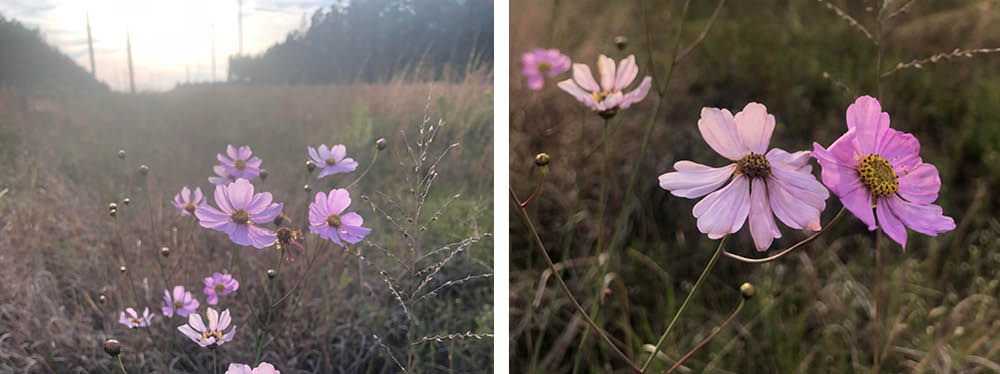
Often rural counties are underrepresented in databases such as botanical voucher specimens to document distribution of native plants and reports of invasive species. Recently Heather Brasell was asked by Linda Chafin, UGA State Botanical Garden to collect voucher specimens from Berrien county. So far, collecting specimens while working on her property, she has collected over 160 species. Karan Rawlins, now retired from UGA Bugwood organization, was responsible for workshops around the state for EDDMapS (Early Detection and Distribution Mapping System) for the Southeast Exotic Pest Plant Council to encourage citizen scientists like us to report occurrences of invasive species. Documenting both native and invasive plants is essential in managing and funding conservation of plant communities.
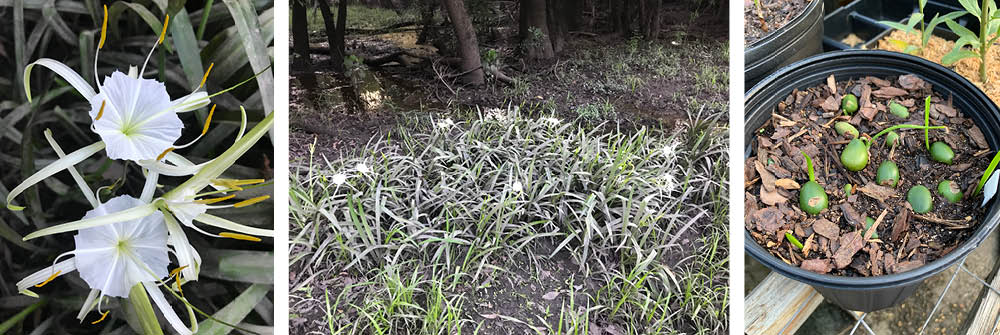
Botanical mysteries demand teamwork. Last year, I asked Karan Rawlins for help identifying invasive plants on my property, focusing on an area where a powerline right-of-way crosses the Alapaha River. Amy Heidt and Paul Sumner joined the exploration. This site has a large community of spider lilies that were at the end of flowering. Amy noticed that the plants were flowering much earlier than the spider lilies she had (Hymenocallis occidentalis) and the leaves were much narrower. So, we started trying to figure out what species it was. Super-sleuth Karan contacted her botanical allies who took over the quest. We needed to provide details of shape and size of flowers and leaves. By the time we went back, there were no more flowers, but Karan led the process of collecting seeds and plants for distributing to different places: State Botanical Garden, Atlanta Botanical Garden, Chattahoochee Nature Center, and the Nature Conservancy. Then we had to wait until they flowered. Henning von Schmeling, Chattahoochee Nature Center, sent updates on the seeds germinating and then finally one of his plants flowered and he was able to identify it as Dixie spider lily, Hymenocallis duvalensis. Henning asked me to check a couple of documented locations and I checked out several additional locations where highways crossed rivers. Amy Heidt, Paul Sumner and I have been checking out even more sites, taking photos to document distribution. We found several new locations. This kind of operation – local eyes on local places - is an important way we can support conservation of native plants.
Who knew?!? Benefits of growing native plants in containers
Gail Farley
The puny plant above left is butterfly milkweed (Asclepias tuberosa). It is about as large as any I’ve tried to grow in our home landscape. No vigor, no blooms and an iffy perennial that may or may not return in the spring. It’s just a wheezy, puny plant that doesn’t like our native, St. Marys sandy soil. I scrapped the idea long ago of ever having this coveted plant in my landscape. That is, until Coastal Plain Chapter member and neighbor, Roberta Lindau, pointed out vigorous, blooming, quite content milkweeds growing in a container on her driveway. I was truly surprised! What special blend of amendments did she use for containers? Roberta said regular, commercial potting soil – whatever brand is on sale at the local hardware store.
Compare the puny milkweed plant growing in the ground to the happy, blooming butterfly milkweed plants growing in the container. Surprise, surprise. All of the plants germinated from the same batch of seeds that Roberta treated with two months of moist sand sclerification in her refrigerator. The contrast is quite striking. It makes a compelling case for growing finicky plants such as Asclepias tuberosa in containers.
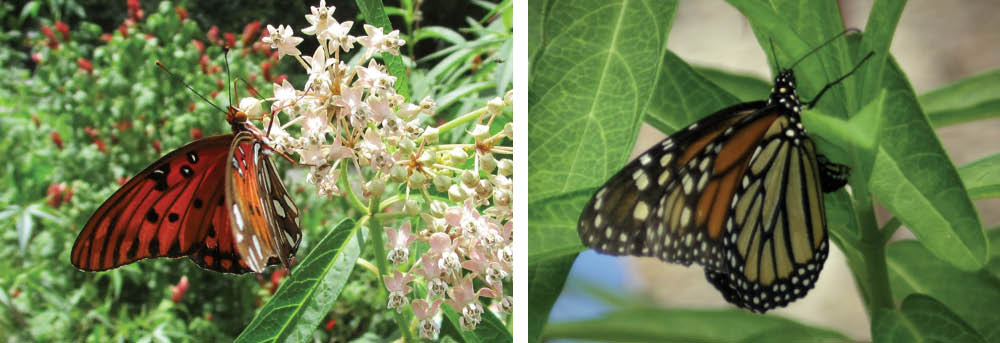
Personally, I’m no stranger to growing native plants in pots. However, I have mostly used containers for wetland plants such as swamp milkweed, A. incarnata, and aquatic milkweed, A. perennis. I have three containers of swamp milkweed that have hosted dozens of monarch caterpillars, provided nectar and pollen for hosts of pollinators, and also have produced seed pods. I had to add milkweeds that were not clones of the original plants to finally get seeds.
A local big box store sells large plastic pots that do not have holes in the bottom. I drill holes about 2 inches up the pot’s side. Water then can pool in the bottom and be wicked up by the roots. Voila – wetland container! I HAVE successfully grown these two plants plus swamp sunflower (Helianthus angustifolia), scarlet rosemallow (Hibiscus coccineus), and lanceleaf rudbeckia (Rudbeckia lacianata). Some plants have proven too big for containers, such as elderberry (Sambucus nigra), or too finicky, such as cardinal llower (Lobelia cardinalis).
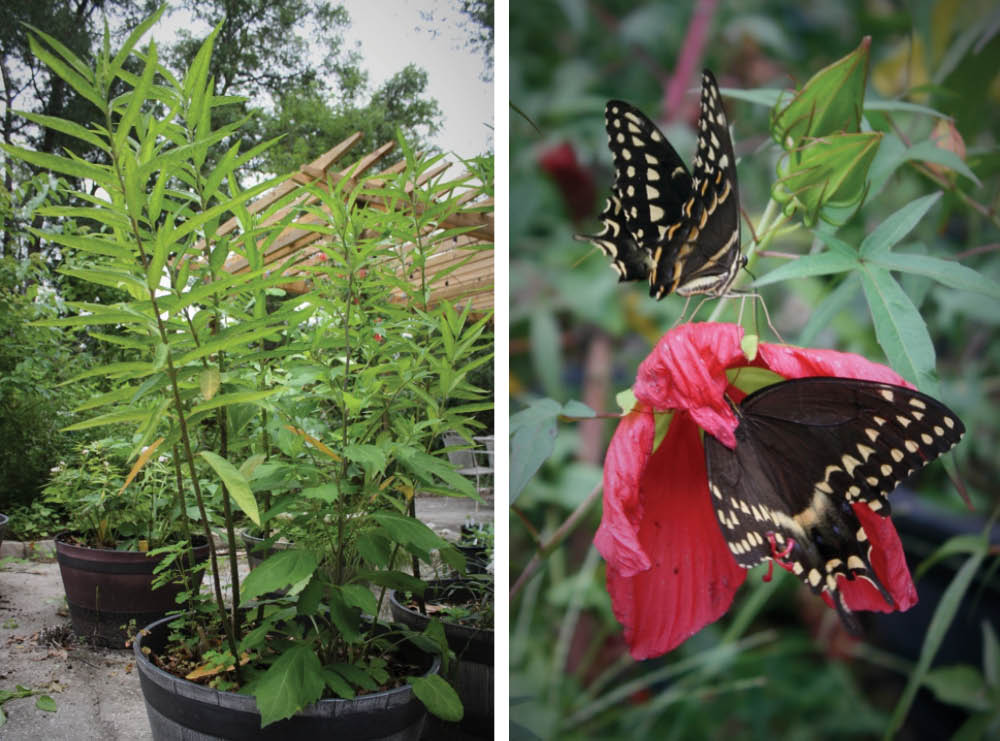
I have always mixed up a blend of shredded pine bark, native soil, sand and some mushroom compost to mimic native soil. Ergo…my HUSBAND has done this! Bags of sand are heavy! And he is the one who’s tasked with moving these heavy pots around on the driveway. Potting mix does not weigh nearly as much. And it is probably cheaper, to boot. The fertilizer that is always part of most potting soil mixes is a concern to me. But given that Roberta’s butterfly milkweed seems quite content and blooming away in potting soil mixed with fertilizer, it IS hard to argue with success!
The native plants Roberta Lindau propagated — butterfly and Whorled milkweed — are featured plants in the St. Marys Garden Club "Early Bird Plant Sale." I'm also selling other propagated native plants: blue false indigo (Baptisia australis), black-eyed susan, red salvia, dune sunflower, Carolina wild petunia, spotted horsemint, and climbing aster.
This is our local CPC Chapter effort to offer native plants to our community. I am co-chair for SMGC 2020 plant sale, an alternative way to introduce native plants through local Georgia garden clubs. A flyer is available here.
Plant Spotlight: Passionflower (Passiflora incarnata)
Greg Lewis
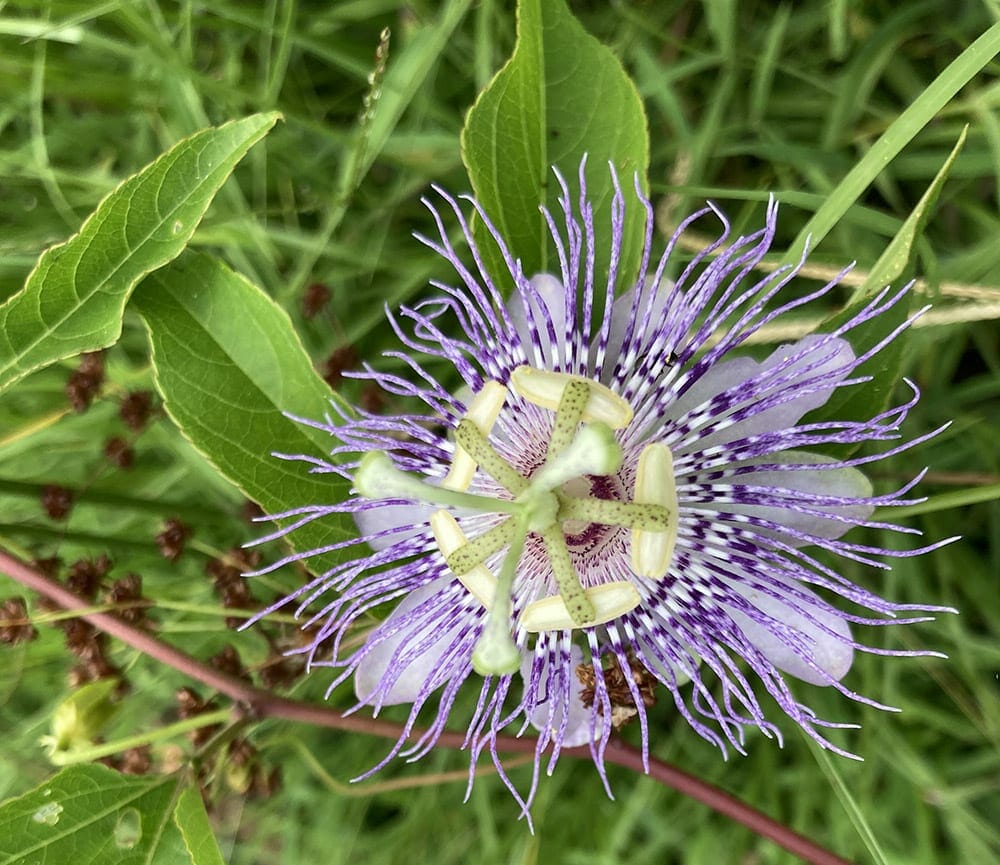
If you are searching for a unique, somewhat different, strange-looking flower, consider the passionflower, Passiflora incarnata. This is really an interesting plant. The genus Passiflora has more than 500 species, most of which are native to the tropics, so there are many instances around the world. We are blessed to have several species in our region. The alien-looking flower is actually blooming in Georgia’s coastal plain right now. Around our property, the passionflower is full of surprises; just a few days ago I found two new instances of passionflower popping up. I find those exciting possibilities for new caterpillars and butterflies. Speaking of which, the passionflower is a host plant for the gulf fritillary (Agraulis vanillae) butterfly and many others including the zebra longwing (Heliconius charithonia), crimson patch longwing (Heliconius erato), red-banded hairstreak (Calycopis cecrops), julia heliconian (Dryas iulia), variegated fritillary (Euptoieta claudia), checkered white (Pontia protodice), cloudless sulphur (Phoebis sennae), and gray hairstreak (Strymon melinus).
But there is more to the passionflower than just being a host plant. It has lovely green foliage, medicinal purposes, and can even be used for adult beverages. It is a staple in many butterfly gardens. We moved into our house about two years ago, and we are performing do-It-yourself landscaping around the house. Of course, the passionflower is included and seems quite happy on the south side of our house, making its way through the berm, untrellised and weaving through the other natives.
Care of the passionflower is simple. Passionflowers grow and bloom best when the soil is kept moist; they need about 1 to 1-1/2 inches of water every week. The vine dies back in winter, but during its active season, it grows from 15-25 feet tall and can spread 5-8 feet. It grows in USDA Plant Hardiness Zones 6 – 11. The passionflower likes full sun to part shade and average soil that is well drained. Pick a spot in the garden where the plants may either climb or spread freely. The plants may be propagated from seed or by cuttings. Seeds should be collected in the fall after the fruit has begun to shrivel. They can also be propagated from softwood cuttings, layering, or rhizomes. Another attribute of the passionflower is its deer resistance, a characteristic that becomes important when the deer are roaming freely around your property.
While this article will not provide any details on the medicinal aspects of the passionflower, there is a long history dating before European arrival, when the native Americans used different parts of the plant for various ailments. Native American tribes used purple passionflower for food, drink, and medicinal purposes.
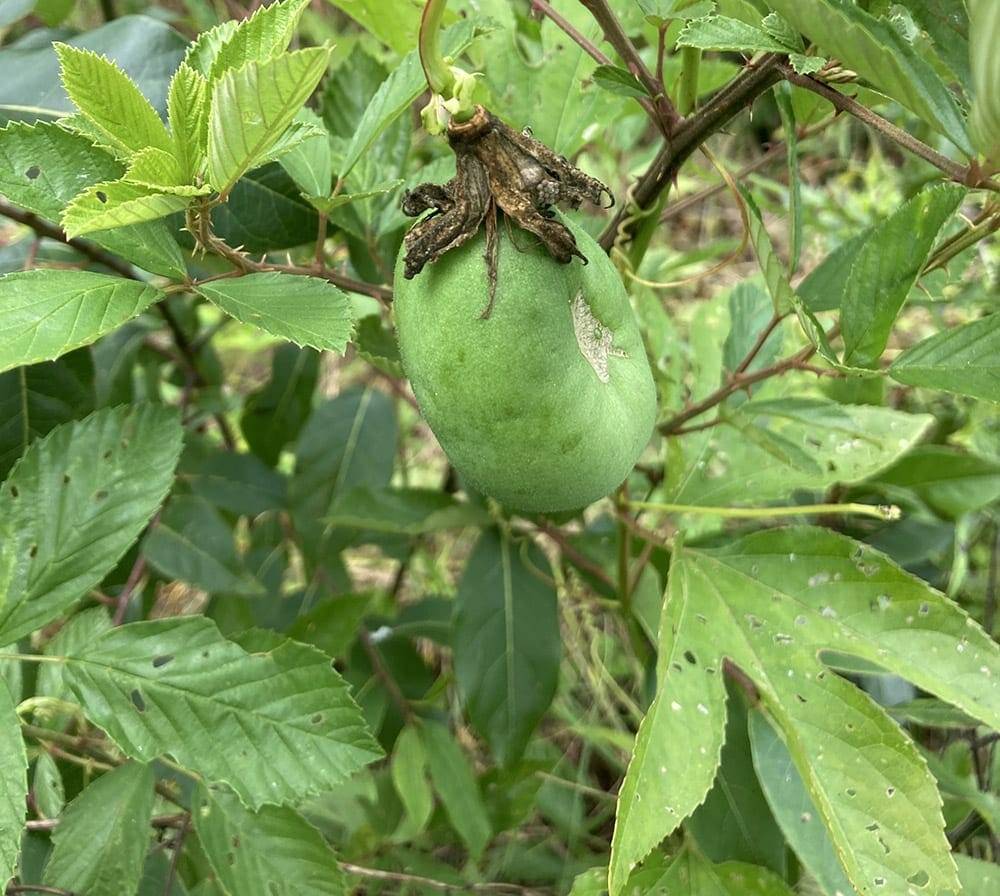
Did I mention the passionflower has fruit? Yes, it is called maypop. It is sweet, yellowish, and roughly the size of a chicken's egg, and sometimes is used in adult beverages. Last year a customer came to buy some passionflower vines-- not for the typical use as a host plant for the gulf fritillary butterfly--but to use in an adult beverage called a Mojito. Apparently, passion fruit juice can be purchased at the grocery store or you can make your own. Be aware, however, the DIY method requires quite a bit of work and is tarter than the sweeter, store bought juice. The customers shared the recipe, so contact the author if you would like to have it.
A question I had was why it was named passionflower. There is quite a story here — the plant of the genus Passiflora has flowers which resemble aspects of the biblical passion. It seems to have first gotten its name in medieval Spain. The Wordsworth Dictionary of Phrase and Fable provides this interesting explanation:
- The leaf symbolizes the spear.
- The five anthers, the five wounds.
- The tendrils, the cords or whips.
- The column of the ovary, the pillar of the cross.
- The stamens, the hammers.
- The three styles, the three nails.
- The fleshy threads within the flowers, the crown of thorns.
- The calyx, the glory or nimbus.
- The white tint, purity.
- The blue tint, heaven.
- It stays open three days, symbolizing the three years' earthly ministry of Jesus Christ.
Finally, the passionflower is a staple in any butterfly garden, and it can provide an exciting launching pad for bringing many varieties of butterflies to your yard. If you decide to incorporate this into your landscape, it is common to plant them in open or cultivated fields, rocky slopes, thin woods, roadsides, fence rows and thickets. No matter the reason or appeal you have to use the passionflower, it is worthwhile for the beauty of the butterfly, the fondness of the flower, and the intoxicating tartness of the maypop’s nectar. Enjoy it.
References:
Brewer, E. C. (2001), The Wordsworth dictionary of phrase and fable, Wordsworth Reference, p. 826, URL.
Passion Flowers (2020) (Passiflora spp), URL.
Peterson, J. S. (2006). Plant guide: purple passionflower Passiflora incarnata L., URL.
Plant profile for Passiflora incarnata L. purple passionflower, PLANTS Database, URL.
Sweet, K.Top 10 Butterfly Host Plants, Birds and Blooms, URL.
|